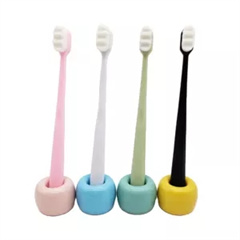**1. ** Age and Development: Choose a toothbrush size that corresponds to your child’s age and development. Infant toothbrushes are designed for babies with emerging teeth, while toddler and child toothbrushes cater to older kids.
**2. ** Small Brush Head: Opt for a toothbrush with a small head that comfortably fits in your child’s mouth and can access all areas, including the back molars.
**3. ** Soft Bristles: Select a toothbrush with soft bristles to prevent gum irritation. Children’s gums are more sensitive, and soft bristles are gentle while effectively cleaning teeth.
**4. ** Handle Size: Ensure the toothbrush handle is easy for your child to grip. A wider handle can provide better control for little hands.
**5. ** Ergonomic Design: Look for a toothbrush with an ergonomic design that promotes a comfortable grip and ease of use for your child.
**6. ** Bristle Arrangement: The bristles should be arranged in a way that allows for efficient cleaning. Some toothbrushes have bristles with different lengths to reach different parts of the teeth.
**7. ** Non-Slip Handle: A toothbrush with a non-slip handle reduces the risk of accidents and ensures your child can maintain a firm grip, especially when brushing in the bathroom.
**8. ** Appropriate Length: The toothbrush should be long enough to be held comfortably, but not so long that it becomes difficult to maneuver inside the mouth.
**9. ** Replaceable Heads (for Electric Brushes): If using an electric toothbrush, consider one with replaceable brush heads. This is especially useful for growing children, as you can switch to a larger head as they develop.
**10. ** Age-Appropriate Features: Some toothbrushes come with features like timers or lights that make brushing fun and engaging. Ensure these features are appropriate for your child’s age.
**11. ** Supervision: Even as children grow, it’s important to supervise their brushing until they can effectively brush on their own, usually around the age of 6 or 7.
**12. ** Regular Replacement: Replace your child’s toothbrush every three to four months, or sooner if the bristles show signs of wear. This ensures optimal cleaning.
**13. ** Consult the Dentist: If you’re unsure about the right toothbrush size for your child, consult your pediatric dentist. They can provide personalized recommendations based on your child’s oral health and development.
Remember that as your child grows, their dental needs will change. Regularly evaluating their toothbrush size and ensuring it’s appropriate for their age and development will contribute to effective oral hygiene and a healthy smile.








